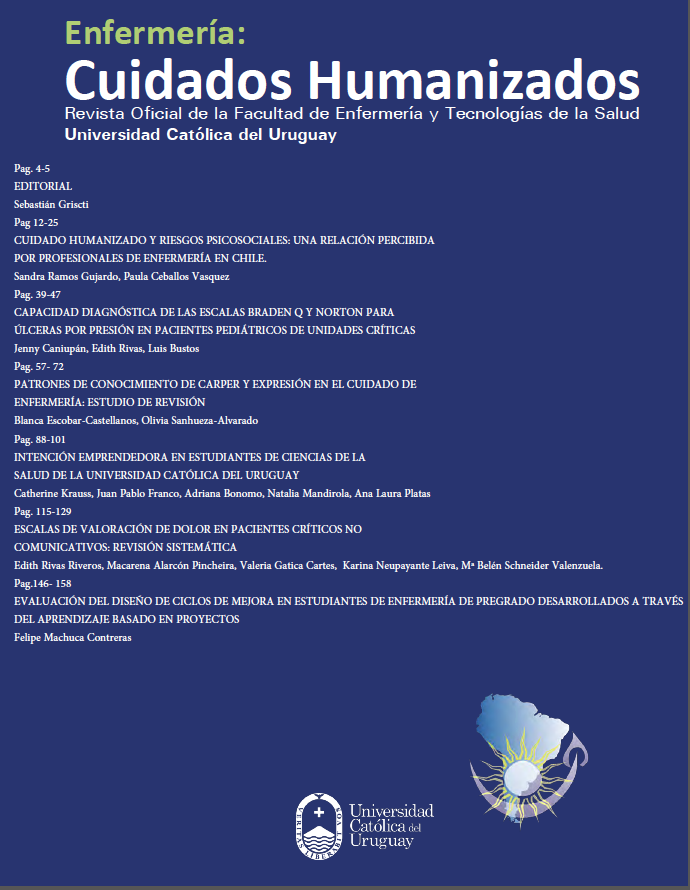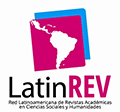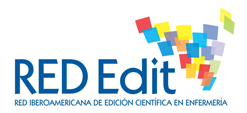Evaluation of the design of cycles of improvement in undergraduate nursing students developed through project-based learning
DOI:
https://doi.org/10.22235/ech.v7i1.1545Keywords:
Investigación en Enfermería, Educación en Enfermería, Estudiantes de EnfermeríaAbstract
The goal of this article is to describe the level of performance in the final product of fifth and ninth grade nursing students who developed an improvement cycle design under the project-based learning methodology. This quantitative descriptive cross-sectional study was developed according to the reliability of the instrument of evaluation of the final product of the improvement cycle developed through problem-based learning was analyzed, the level of performance was described according to the level of the student's study plan and the theoretical relationships were analyzed. The final product evaluation tool of the improvement cycle developed by problem-based learning obtained Cronbach's alpha of 0.852. Statistical analysis of ANOVA (F = 3,155, P = 0.057) showed no differences in the level of performance. But the Tukey HSD test indicates that ninth semester students concentrated (M = 121.00, DS = 12.12) have significantly higher performance scores. The conditions for a better performance in the product of the improvement cycle developed through problem-based learning were observed in the following characteristics: higher level in which the students took the course, greater number of tutoring hours, lower number of students per teacher and fewer students per group.
Downloads
References
Machuca Contreras F, Medero Loyola K, Zapata Aqueveque C. Cuidados al final de la vida: Una reflexión a partir de los patrones del conocimiento. Cuidado de Enfermería y Educación en Salud. 2015; 2(1):63-83.
Hills M, Watson J. Creating a caring science curriculum: an emancipatory pedagogy for nursing. New York: Springer; 2011. 310 p.
Pylyshyn ZW, LePore E. What is cognitive science? [Internet]. Blackwell; 1999 [citado 23 de julio de 2017]. Disponible en: http://www.cs.ox.ac.uk/ieg/e-library/sources/ruccsbook.pdf
Lagos Coutiño R, Cárdenas Mas G, Formandoy Morales F, Guerrero Villalba R, Lastra Cid L, Pajkuric Vitezic LE. Manual de técnicas didácticas para el desarrollo de competencias. Primera. Concepción, Chile: Instituto Profesional Virginio Gómez; 2015. 88 p.
Biasutti M, EL-Deghaidy H. Interdisciplinary project-based learning: an online wiki experience in teacher education. Technology, Pedagogy and Education. 2015; 24(3):339-55.
Harmer N, Strokes A. The benefits and challenge of project-based learning. A review of the literature [Internet]. United Kingdom: Plymouth University; 2014 [citado 24 de julio de 2017] p. 38. (PedRIO). Report No.: 6. Disponible en: https://www1.plymouth.ac.uk/research/pedrio/Documents/PedRIO%20Paper%206.pdf
Cabadas Avión R. La calidad asistencial: ¿de qué estamos hablando? Cirugía Mayor Ambulatoria. 2015; 20(2):79-82.
Rodríguez Pérez MP, Grande Arnesto M. Calidad asistencial: Concepto, dimensiones y desarrollo operativo [Internet]. Madrid, España: Escuela Nacional de Sanidad; 2014 [citado 25 de julio de 2017] p. 35. Disponible en: http://e-spacio.uned.es/fez/eserv/bibliuned:500957/n14-1_Calidad_asistencial.pdf
Salinas M, Flores E, López-Garrigós M, Díaz E, Esteban P, Leiva-Salinas C. Aplicación de un método de mejora continua para la selección de los marcadores diagnóstico de pancreatitis aguda en un servicio de urgencias. Emergencias. 2017; 29:113-6.
Patón Villar F, Lorente Granados G, Fernández-Lasquetty Blanc B, Hernández Martínez A, Escot Higueras S, Quero Palomino M, et al. Plan de mejora continua en prevención-tratamiento de úlceras por presión según el ciclo de Deming. Gerokomos. 2013; 24(3):125-31.
Machuca Contreras F. Evaluación y Mejora del Mantenimiento del Potencial Donante en la Unidad de Cuidados Intensivos Adultos del Hospital San Pablo de Coquimbo, Chile. Cuidado de Enfermería y Educación en Salud. 2014; 1(1):16-24.
Calle-Urra JE, Parra-Hidalgo P, Saturno-Hernández P, Fonseca-Miranda Y, Martínez-Martínez M. Evaluación y mejora de la calidad de los documentos de consentimiento informado en nueve hospitales del servicio murciano de salud. Revista Española de Salud Pública. 2015; 89(3):307-19.
Saturno Hernández PJ. Gestión de la Calidad. Concepto y componentes de un programa de gestión de la calidad. 2a ed. Murcia, España: Universidad de Murcia; 2008. 20 p. (Manual del Máster en gestión de la calidad en los servicios de salud; vol. Conceptos básicos. Diseño e implantación de programas de gestión de la calidad en los servicios de salud.).
Torres Jaquez ME, Contreras Loera MR. Las organizaciones cooperativas: el proceso administrativo como parte de la gestión directiva. Journal of Intercultural Management. 2013; 5(1):51-61.
Rodríguez Reinado C, Blasco Hernández T. Recomendaciones para la buena práctica en la implementación del ciclo de mejora en calidad asistencial. Madrid, España: Instituto de Salud Carlos III; 2013 nov p. 55.
Ayala RA, Koch TF, Messing HB. Understanding the prospect of success in professional training: an ethnography into the assessment of problem-based learning. Ethnography and Education. 2017; 0(0):1-19.
Emanuel EJ, Wendler D, Grady C. What Makes Clinical Research Ethical? JAMA. mayo de 2000;283(20):2701-11.
González Alonso J, Pazmiño Santacruz M. Cálculo e interpretación del Alfa de Cronbach para el caso de validación de la consistencia interna de un cuestionario, con dos posibles escalas tipo Likert. Revista Publicando. 2015; 2(1):62-7.
Domínguez-Lara SA. ¿Por qué es importante reportar los intervalos de confianza del coeficiente alfa de Cronbach? Revista Latinoamericana de Ciencias Sociales, Niñez y Juventud. 2015; 13(2):1326-8.
Rubio-Hurtado M-J, Berlanga-Silvente V. Com aplicar les proves paramètriques bivariades t de Student i ANOVA en SPSS. Cas pràctic. REIRE Revista d’Innovació i Recerca en Educació. 2012; 5(2):83-100.
Keppel G, Wickens TD. Simultaneous comparisons and the control of type I errors. Design and analysis: A researcher’s handbook 4th ed Upper Saddle River (NJ): Pearson Prentice Hall p [Internet]. 2004 [citado 23 de julio de 2017];111-30. Disponible en: http://www.skidmore.edu/~hfoley/Handouts/K.Ch6.notes.pdf
Robinson JK. Project-based learning: improving student engagement and performance in the laboratory. Analytical and Bioanalytical Chemistry [Internet]. 2013; 405(1):7-13.
English MC, Kitsantas A. Supporting Student Self-Regulated Learning in Problem- and Project-Based Learning. Interdisciplinary Journal of Problem-Based Learning. 2013; 7(2). 128-50.
Lee D, Huh Y, Reigeluth CM. Collaboration, intragroup conflict, and social skills in project-based learning. Instructional Science. 2015; 43(5):561-90.
Notari M, Baumgartner A, Herzog W. Social skills as predictors of communication, performance and quality of collaboration in project-based learning: Social skills in project-based learning. Journal of Computer Assisted Learning. 2014 ;30(2):132-47.
Downloads
Published
How to Cite
Issue
Section
License
Copyright (c) 2018 Enfermería: Cuidados Humanizados

This work is licensed under a Creative Commons Attribution 4.0 International License.

















